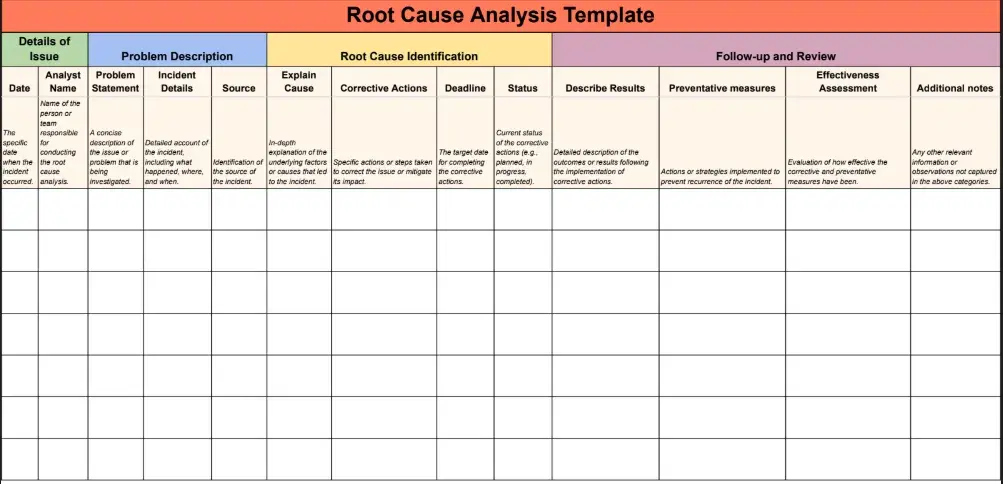How I Used Root Cause Analysis to Turn Organizational Problems Into Opportunities

I’ve faced plenty of problems when building content teams. Sometimes, those problems led to outright failures. Content falls flat, email campaigns flop, or new hires don’t work out.

At times, it feels easier to just accept reality and move on. “Well, that new hire wasn’t the right person for our team right now. We’ll do better next time!” But, if you don’t understand why that hire didn’t work out — if you fail to understand the real problem — you’re bound to repeat it.
Conducting a root cause analysis (RCA) helps you confront your perceived reality and truly understand what went wrong so you don’t repeat history. Now, that can sound a little scary.
After all, while we’ve been told for years that learning from failure is key to growth, admitting to failure feels vulnerable. What if I am the problem? What if it’s something I cannot fix?
The RCA process helps us work through those fears using a data-driven approach and critical thinking. It asks us to eschew the easy answer and chase deeper truths. From there, we can build a more informed and practical approach to challenges. We fail, we learn, and we improve. That’s the goal of a good RCA.
How do you run a root cause analysis, and what tools can you use to do it effectively? Grab your free root cause analysis template, and let’s get into it.
Table of Contents
What is root cause analysis?
A root cause analysis (RCA) is the process of analyzing a problem to find its underlying causes instead of simply treating the surface-level issues.
Marketers experienced in project management know it’s important to monitor your systems and take an honest look at things when they break down. RCA offers a framework to better understand how organizational components work together and how it can improve.
To help us unpack RCAs, I talked with Ellen Smolko, a fractional CMO at Foresight Performance. She’s helped many companies analyze business problems with RCAs and find significant value in the process.
“Root cause analysis helps you move past surface-level symptoms and tackle the true sources of underperformance,” Smolko said.
“For example, if sales are down, it’s tempting to assume you need more leads. But often, the real problem lies deeper: perhaps your offerings no longer meet evolving customer needs, or your messaging fails to communicate value. By systematically identifying and addressing these root causes, RCA enables you to make informed decisions that lead to lasting improvements.”
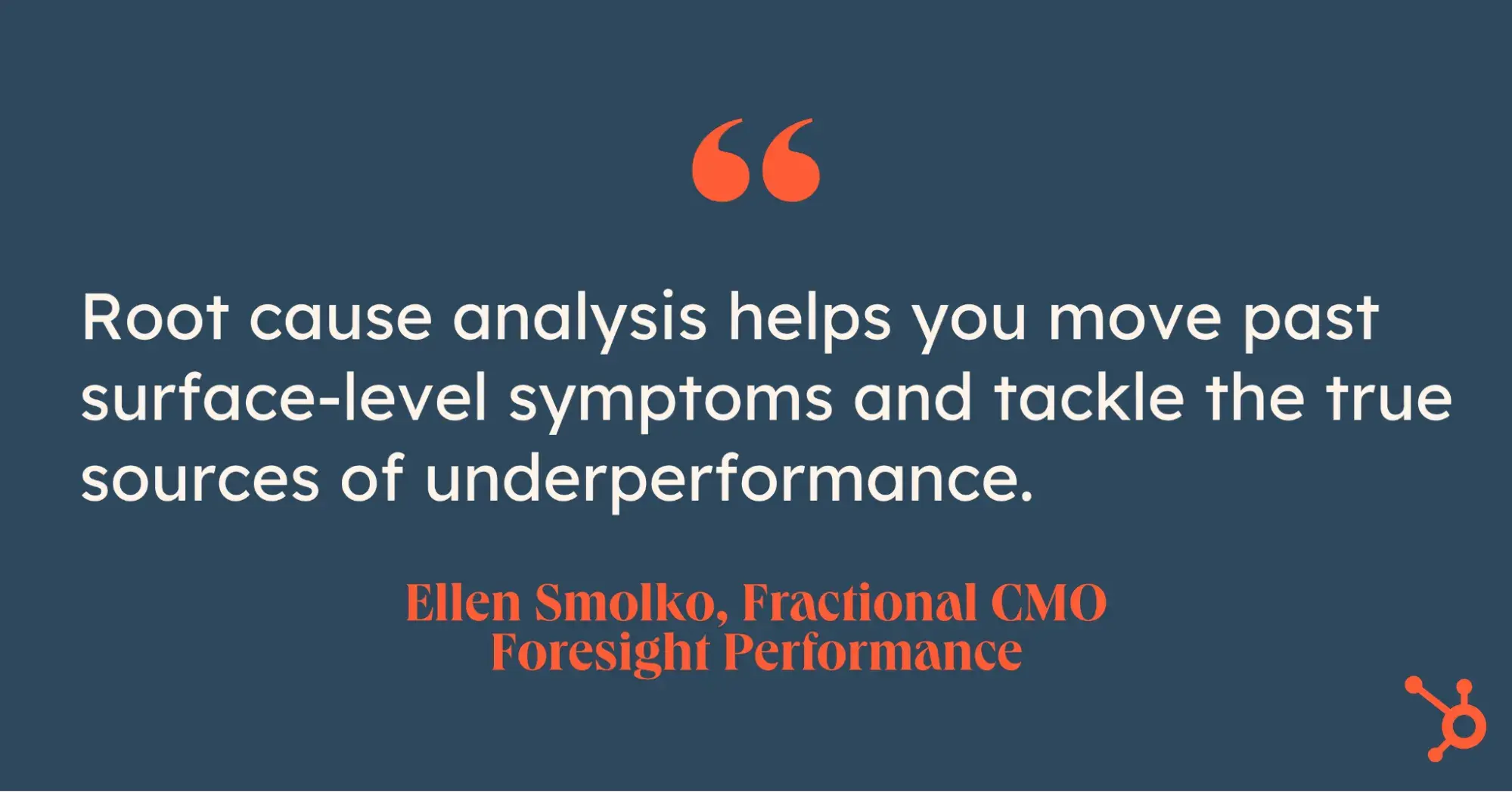
What is the “5 whys” approach for a root cause analysis?
An RCA’s purpose is to identify the root cause of a problem. That means that when we’re confronted with a problem, we can’t accept our first instinct.
We need a framework to help us question the people, processes, tools, systems, and environments influencing a negative outcome.
That’s where the “5 Whys” comes into play. In the 5 Whys approach, you repeatedly ask why a problem happened to drill down past the obvious answers and find the underlying root cause. Sakichi Toyoda pioneered this technique and applied it liberally in the company he founded — Toyota Industries.
As an example, I’m going to apply the 5 Whys to my new hire example from before.
Several years ago, I was building a content team from scratch. We had an urgent need to meet client expectations with stellar written content. But, our content was falling below that expectation, and our new hires were turning over voluntarily and involuntarily within 12 months.
Why was this happening?
Why 1: Why are new content hires not meeting performance expectations and leaving so soon?
An important piece of the 5 Whys exercise is to use objective data as much as possible. We often build subjective assumptions around people and processes and let those influence decision-making:
“The new hires just don’t get it.”
“They’re not spending enough time understanding their customers.”
“They’re not surfacing their own problems fast enough.”
But, does the data we gather bear out those assumptions? During this exercise, set aside what you think you know and focus on what you can prove.
Pro tip: Using data to support decisions is a key tenet of total quality management — and simply a good practice to lean on when advocating for complex organizational changes.
In this case, I looked at quality control data provided by clients and team leads, as well as satisfaction surveys from staff. From those data points, I found that several team members were unhappy with their roles. These team members were also the ones clients flagged as producing content that didn’t meet expectations.
It’s tempting to stop here; after all, doesn’t this back up our subjective assumptions? The new hires clearly don’t get their clients. But, the 5 Whys has us go deeper.
Why 2: Why are team members unhappy with their roles and not meeting client expectations?
I could sense team members were frustrated, and the data supported that feeling. And clients were certainly vocal about their frustrations as well.
So, I dug deeper into the quantitative hiring, onboarding, and performance data. I also ran more qualitative surveys, talking with current team members about their struggles and what they felt was happening.
Analysis at this stage uncovered two key learnings:
Unhappy team members felt overwhelmed by the number of clients and their expectations.
They weren’t getting enough feedback and support to adjust to those expectations and improve their performance.
Why 3: Why are team members feeling overwhelmed and lacking sufficient feedback and support?
You’ve probably noticed a trend with these questions: the previous conclusion informs the next question. That’s the secret to a good 5 Whys session — you keep interrogating.
You also might start taking things personally at this stage of the process. I felt I owned a significant piece of this problem. They were my team — were they not getting enough help from me? What was I doing wrong?
There’s a place in this process for extreme ownership and to follow through on improvements personally. But, remember that we need data to back our decisions. We have to continue objectively to ensure we really understand the root cause.
So, I talked with our talent management, and we dug deeper into the hiring and onboarding process, including screening questions, writing test analysis, and early hire management practices. The data showed us:
We were not thoroughly assessing content team candidates’ skills and abilities for a match to the role.
We lacked consistent performance reviews and mentorship to ensure feedback turned into professional development opportunities.
Why 4: Why was there a role mismatch and a lack of performance reviews and mentorship?
We reviewed hiring and onboarding data and saw how fast managers pushed to hire. We had a fair number of steps in our hiring process, but we could move through those steps quickly (and, perhaps, too quickly).
Looking at onboarding, we also found our process covered the usual administrative tasks like taking PTO or logging client hours. Yet, we hadn’t addressed the need for continuous performance management or close mentorship.
Why 5: Why were we hiring so quickly and using a limited onboarding process?
At this stage, you can see how organizational goals and challenges influenced my team. Our company was growing rapidly, and client count and expectations grew accordingly. Growth pressured the hiring managers, who wanted to just get people onto the team to meet ballooning demand.
The rush also led to a rushed onboarding process. We were so focused on getting team members that we didn’t put enough energy into keeping them. We were missing a strategic focus on long-term team development, which included deeper onboarding and more effective mentorship and performance management.
Using the 5 Whys to Improve Your Organization
From this approach, we took measures to make substantial improvements:
Reassessing the pressure to scale quickly.
Tinkering with hiring and onboarding processes to find best-fit people for our growth stage.
Implementing more structure and feedback opportunities to boost performance.
Doubling down on team development as a core component of managers’ roles and responsibilities (including my own role).
These changes helped build a stronger, more resilient team who consistently met and exceeded client expectations. It wasn’t a perfect solution — growth always surfaces new challenges. But, it got us going in a more informed direction.
Pro tip: You can run the 5 Whys with nothing more than a whiteboard and dry-erase marker, but it’s tough to think through challenges on the spot. I recommend using our 5 Whys template to break through barriers and start mulling.
It’s also vital to note that you can only perform the 5 Whys successfully if your company culture can accept failure and not resort to blame and distrust. While you should own failure and learn from it, you cannot do so in a place where you don’t feel safe.
That lack of safety leads to ignoring data that points to the “wrong” conclusion, not fully analyzing the situation, or failing to follow through on needed changes.
My experience also raises an important point of caution that Smolko echoed.
“While straightforward, the 5 Whys method has limitations,” she said. “It assumes a single root cause and relies heavily on accurate data. Many marketing challenges are multifaceted, requiring deeper exploration and validation.”
This approach helps you get started, but a true root cause analysis should push you beyond a single-cause mentality.
What tools can help you with root cause analysis?
After you’ve run your 5 Whys approach, you should have a better sense of root causes. But, like Smolko mentioned, there are more places begging for deeper review and critical thinking. RCAs can use different approaches and tools to help unpack complex challenges.
Fishbone Diagrams
You may also see these called Ishikawa diagrams or cause-and-effect diagrams, but they’re called fishbone diagrams because they look like a fish’s skeleton. These diagrams help you map potential contributing factors to your specific problem.
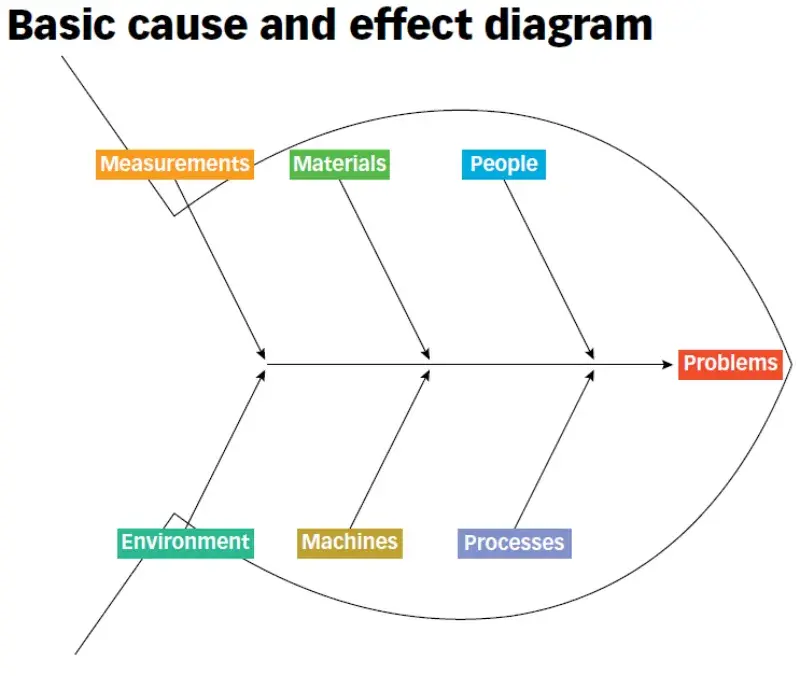
Begin by placing your problem at the “head” of the fishbone. Then, identify major categories like people, processes, and tools. Under each category, brainstorm all possible causes contributing to the problem. For instance, I would put “speedy hiring and onboarding” under the processes category.
Finally, analyze how these causes relate to each other and your problem. The fishbone visual helps you organize thoughts around complex problems and spot missing connections and opportunities.
Pro tip: If you’re looking to hop right into a fishbone diagram exercise, check out our free fishbone diagram template for a head start.
Affinity Diagrams
An affinity diagram helps you organize and analyze large data sets. You place data and ideas into groups based on their relationships with each other.
Start by gathering data from multiple sources, focusing on anything pertinent to your problem. Then, define categories and sort that data into groups. Label each group and analyze potential connections for patterns and potential root causes.
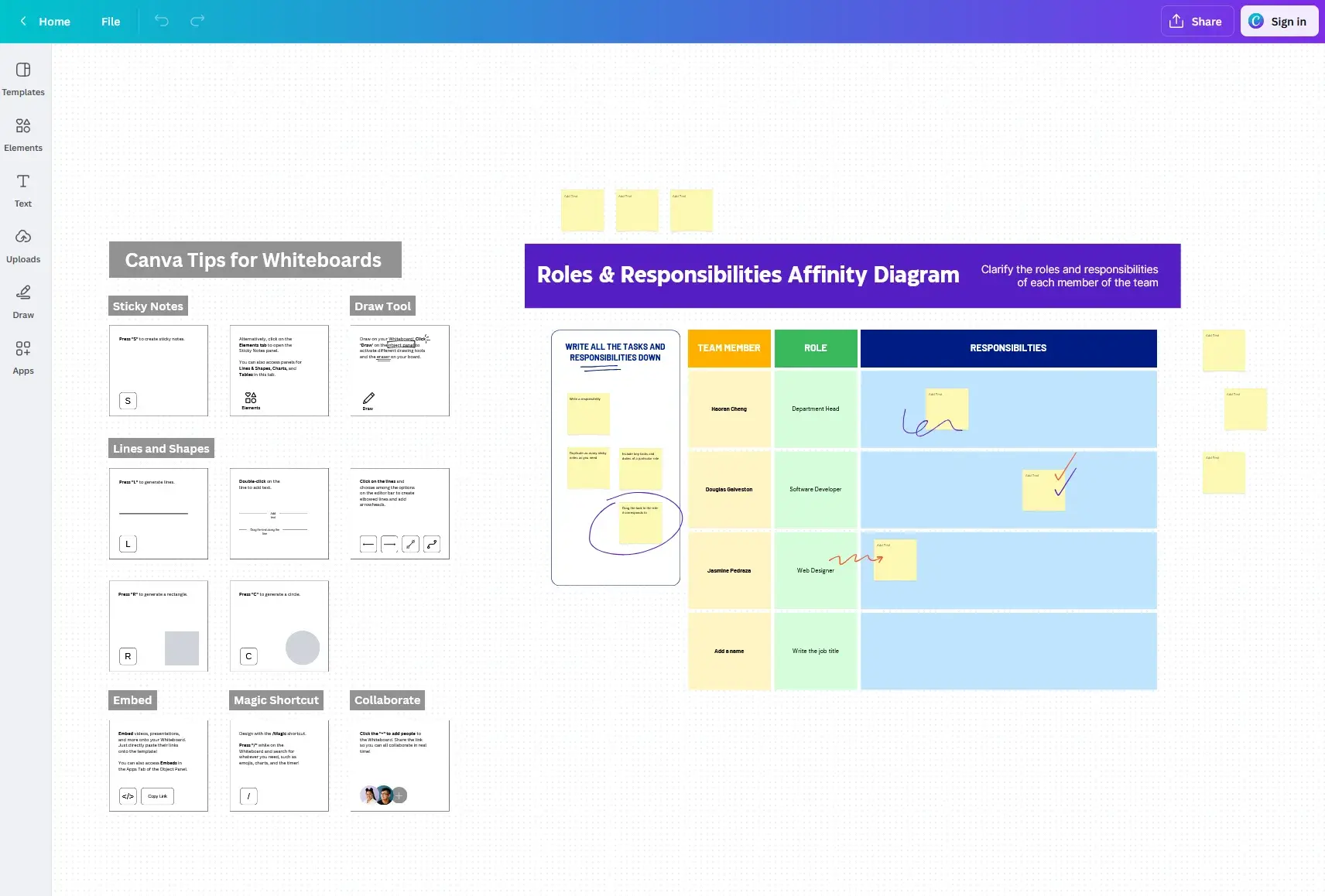
For my team’s challenges, I could grab data from exit interviews, performance metrics, and qualitative surveys from clients and team members. Natural buckets like Training Deficiencies or Lack of Support might surface, and connections between data would show them as points to begin addressing immediately.
Pareto Charts
If you’ve been around project management, you’ve heard of the Pareto Principle or the 80/20 Rule. Succinctly, it’s the concept that things in life aren’t distributed equally. As in, 80% of your company’s production comes from 20% of its workers.
Applied to RCA, a Pareto chart operates from the underlying concept that a few root causes are responsible for most of your problems.
Start with a list of potential causes related to your problem. Then, you count every time to see each cause affecting the outcome in your data. The causes with higher frequency tend to be the “bigger challenges” to solve.
For instance, while going through my 5 Whys exercise earlier, we could categorize my team’s frustrations and count instances where it appeared in the data. Inadequate training may have appeared 15 times, while high workload only appeared 5 times.
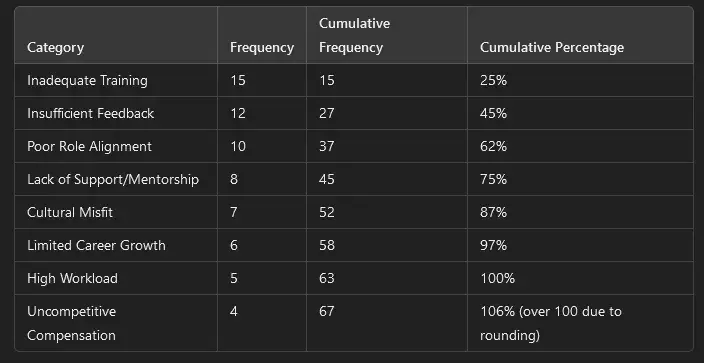
I would read this chart and see we need to focus on training opportunities, as that would more effectively address the root cause of our retention issue. This chart helps you spend time on the weightier root causes and make a greater impact.
Failure Mode and Effects Analysis (FMEA)
RCAs often take place after a problem emerges. However, an FMEA focuses on identifying failure points before they break. In this process, you assess possible root causes for failure and prepare actions to mitigate problems.

Part of the FMEA is to rate from 1-10 the severity, occurrence, and detectability of each failure mode. Or, basically:
How bad would it be if it happened?
How likely is it to happen?
How easily can we tell it’s happening?
From there, you derive a Risk Priority Number and build plans to address the highest-risk failure points. It’s a great way to sniff out problems early and prioritize limited resources toward the biggest potential challenges.
Start Your Root Cause Analysis With Our Free Template
You can run these RCA tools without specialized resources. Microsoft Excel or Google Sheets can help you accomplish this process. Some specialized data-driven tools, such as Minitab or Tableau, can help with more complex challenges.
At HubSpot, we see many opportunities where a root cause analysis can help your marketing team. So many, in fact, that we compiled our best tools and resources into a template. Open this template in Word, Excel, Google Docs or Sheets and follow our guided steps through a complete RCA.
Inside our template, you’ll find places to track event dates, customer details, and descriptions of problems. You can then assign investigators, track possible root causes, and build suggested solutions.
This template will help you make informed, data-driven decisions and focus on consistent organizational improvements.
Don’t Fear the Root Cause Analysis
A good root cause analysis should make you a tad nervous.
Confronting underlying issues with organizational problems requires asking tough questions, sharing openly and honestly, and being vulnerable with your role and responsibilities. It’s a humbling process at times.
But, I think it’s also an important process. Follow the steps behind an RCA and use the tools and data at your disposal, and you’ll find the real issues holding you back from success.
If you’re looking to build toward long-term achievement, don’t let fear limit you.
Dig deep and find the keys to victory.

